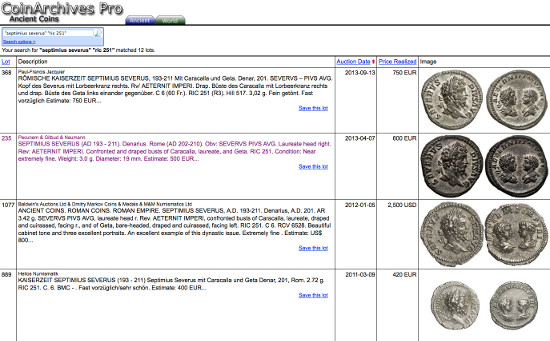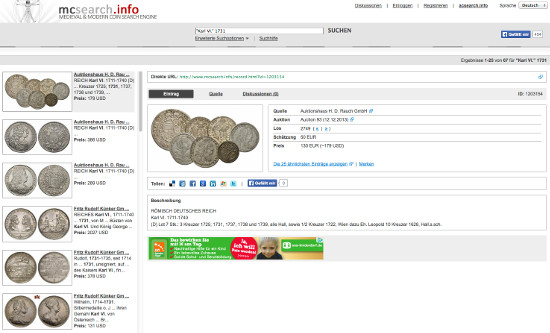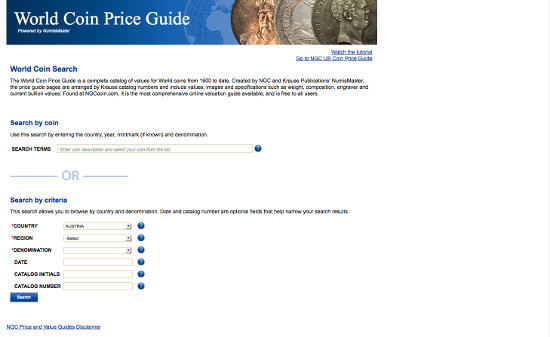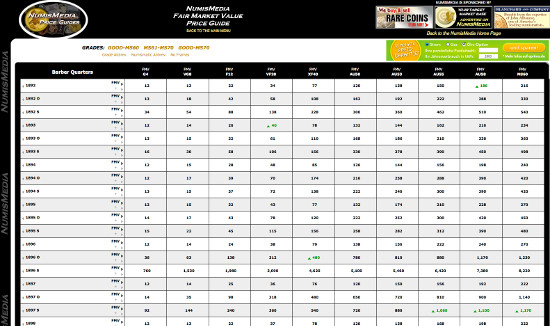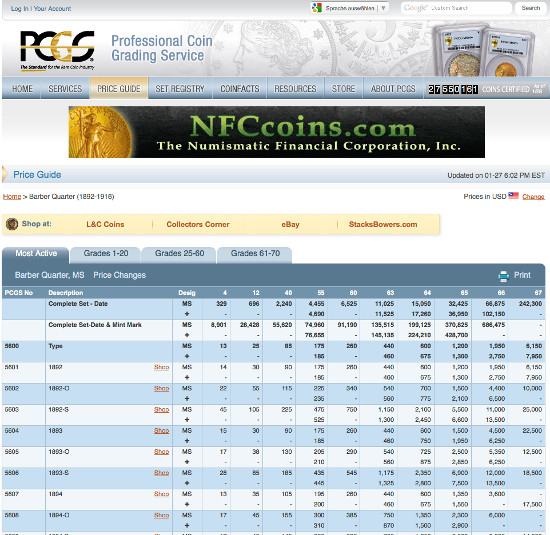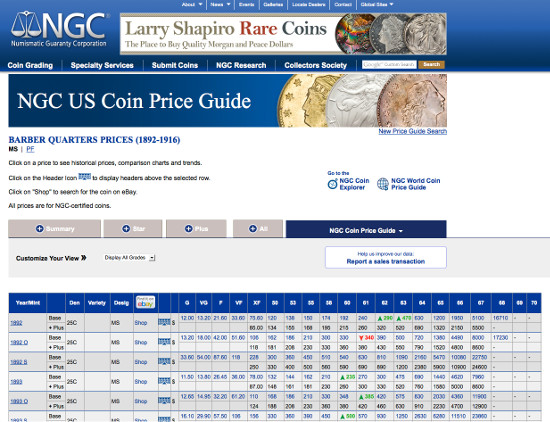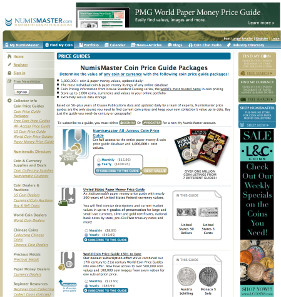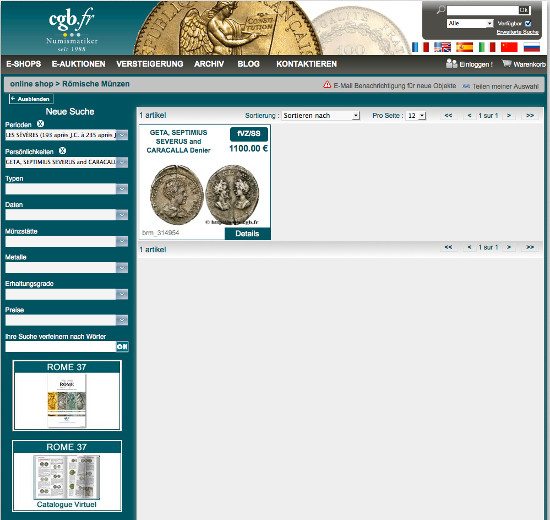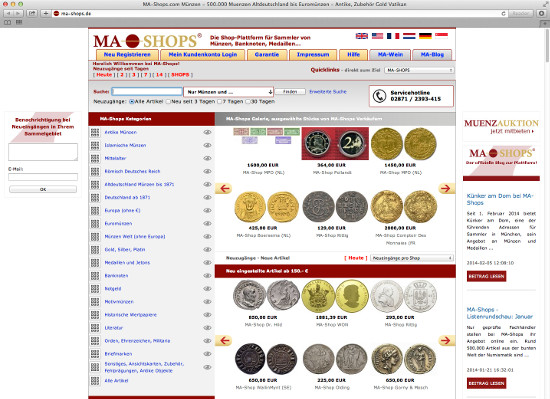by Björn Schöpe
February 13, 2014 – Collecting coins sometimes also includes selling them. That happens for a variety of reasons – a change of the collecting field, the desire to sell a double piece, the plan to invest money in other, more important items etc. – but one thing always stays the same: everyone wants to obtain the best price possible for his or her coin. But what is a coin actually worth?
The value of a coin depends on what the collectors – the market – are willing to pay for it at the material time. And that might vary considerably. A coin can increase or decrease in value, and nobody is likely to have enough time to stay informed all the time of how much a coin of his or her may obtain at present. Naturally, the first advice is to contact a dealer of confidence. Talking to other collectors can be helpful, too.
Many collectors, however, want to inform themselves first of all. The conventional thing to do is checking with the catalog. Albeit, printed catalogs – despite their being popular – have the disadvantage of becoming outdated quickly, and nobody can really purchase an updated edition of the same catalog every few years, even less when the enthusiasm for coins covers several different collecting areas at once. After all, a collector wants to spend his money not just on catalogs but on coins as well.
Apart from the catalogs, a check on the internet can be a good alternative. There are plenty of webpages available, many of them being for free. But how to get information that is reliable? And: what kind of information is actually provided? We have asked ourselves that very questions and have checked and evaluated different portals and websites, databases and search engines.
To come straight to the point: once you test different websites it becomes clear very quickly that there is actually a two-part market out there. Technically speaking, the offers can be divided into those for US American coins and those for ‘world coins’. We chose one coin from each area for reason of testing: a denarius of Septimius Severus, exhibiting the portraits of his two sons, Geta and Caracalla, on its reverse (RIC 251); a Hall ¼ thaler of Charles VI 1734; a Barber Quarter 1893 MS63; and a modern coin from Mongolia from 2007 depicting a wolverine that was conferred a COTY Award amongst others. This is not the place to elaborate on the prices researched in every detail. Rather, the aim is to point out the distinctions, the pros and cons of the different tools.
Basically, there are two kinds of databases. One of them states results from auction sales. In that case, a portal feeds in data from different auction houses and lists the coins – most of them come with illustrations – and the descriptions provided by the auction houses including estimates and results achieved. In that case, it is left to the user to reflect about how much his coin might have changed in value since, let’s say, an auction that was conducted in 2004. Probably the most important portals are CoinArchives and acsearch (for ancient coins) and mcsearch (for coins from medieval and modern times), respectively. The spectrum of these portals covers almost the entire range of coins.
For US American coins, in contrast, there are databases of the grading companies PCGS and NGS as well as of NumisMaster and NumisMedia. These databases are based on ‘market values’, hence results obtained at auction sales, by dealers or eBay. NumisMaster and NGC also provide data by editing the material of the current Krause Standard Catalog of World Coins.
CoinArchives.
But let us have a look first at what a collector awaits who wants to sell his Septimius Severus. In all likelihood he will visit CoinArchives first. Actually, there is an open-access available but that is limited to 100 hits and doesn’t include any additional options. The access for CoinArchives Pro costs 600 US dollar per year (or 451 euros) and there is an educational discount. One can choose between ‘Ancient Coins’ and ‘World Coins’. You may enter, for example, the RIC number into the full-text search. However, there is a possibility that not all records are being found that way. ‘RIC 251’ does not find the coin if the description that had been fed into the database still states the volume, or if you omitted the space in between.
If requested, CoinArchives likewise show similar results. Albeit that ‘similarity’ is a relative one and it is helpful only to a limited extent. The site’s graphic design may seem somewhat outmoded but is has the great advantage that the relevant data can be viewed already on the very first list of results including, and that has to be emphasized, the accurate description, the estimate and the price realized. Likewise the illustrations can be inspected at a glance, and you can enlarge the image by clicking it so you don’t have to work through the individual search results. That can save much time. Speaking of images – it is important that with such kind of investigation you can carefully assess the quality of a coin that obtained a given result. The illustrations at CoinArchives, however, vary to a great extent. Some images are magnificent and high-resolution, while others merely come as thumbnails. The database has no guidelines to be met and so everything depends on the individual auction houses. The user can also file individual coins, which makes it easier to make comparisons between them later. The catalog of ancient times comprises roughly 632,000 coins, the catalog of world coins include 1.59 million specimens.
acsearch.
As of late, the alternative acsearch has commenced to compete against CoinArchives. It wins its first brownie point (from the view of a hobby collector who uses the project every now and then) because of its operating on a non-profit basis (donations are requested). The design comes over pleasantly brisk and tidy. Once you use the tool, however, it soon becomes apparent that the perceived clarity diminishes. The results are similar to those of CoinArchives but you have to click every single hit to be able to read the details. That is much more cumbersome. If you don’t shrink from the gratis sign up you will be provided a saving option here, too. As with CoinArchives, the option of showing the 25 most similar results can help keeping the number of mistakes down due to variant forms of spelling in the records.
It is something of a disappointment, however, that the images have apparently been reduced deliberately. Sometimes the same illustrations can be found as at CoinArchives, but they come in a significantly smaller resolution. Here, potential of illustration is wasted for the sake of uniformity. That is a pity, since the user can only make a rough guess if the object he looks at is really the item wanted because of the small image size. According to the project designers, acsearch contains 661,000 or so ancient coins…
mcsearch.
…while the sister project mcsearch comprises roughly 1,063,000 records of medieval and modern coins.
Wildwinds.
The Wildwinds site refers to itself as reference resource for the valuation of ancient specimens albeit there are no prices or auction estimates stated on the entire site. Unfortunately, the tool gives the user a good deal of trouble. When you know the catalog number of a coin you can access the data of the Sear catalog or the RIC. There doesn’t seem to be any helping tools or full-text search integrated. Loading hundreds of coins on a single page with illustrations in chronological order of the emperors takes ages. Admittedly, the search engine is free of charge, but couldn’t convince in the test.
Coinvac.
Only recently, the Coinvac site has called attention to itself when it reported to have entered its millionth record. Now, the site proudly refers to itself as ‘The world’s largest ancient coin database’. In the previous year, it was still possible to use the database without restrictions for free via a guest access. The lion’s share of the coins (which date to ancient times almost exclusively) came from eBay auctions. But the real problems laid both in the material and the search options. If you searched for RIC number 251 no results were found, the quest for ‘Septimius Severus’, in contrast, yielded more than 3,880 hits that indeed could be further specified according to denomination – but the ‘types’ offered, like Aequitas or Juno, weren’t helpful. Geta and Caracalla with Septimius Severus achieved one single hit dating to the year 2002 with a small image, and the full-text search was pointless as well. Thus, the desperate user could click through 3,504 results that likewise seemed to come from eBay for the most part.
In the meantime it turned out that the host had used and made the images accessible apparently without stating the copyright owner’s name and without asking his permission. After the latter had lodged a complaint, access is restricted to single cases only, when the host admits users on an individual basis. We can’t approve of that procedure. Thankful as we are for databases free of charge, the rights of all parties involved have to be protected. That this is possible is evidenced by other offers. But besides that, Coinvac didn’t offer any satisfying search options for our kind of investigation.
CoinArchives.
The ¼ thaler of Chales VI achieved similar results in the comparison of CoinArchives and mcsearch and revealed the same strengths and weaknesses. In this case, however, two other portals can be of use: NumisMaster und NGC, which takes us across the Atlantic Ocean.
The world of American numismatics is wired differently. While the portals examined so far basically provide a basis for the auction house to present their material as it wishes, causing differences in abbreviations, descriptions, image quality etc., the American catalogs are characterized by their homogeneity. They are catalogs in the proper meaning of the word. Two of them are accessible for free, two other only for cash.
As for world coins one thing is for sure: there is no reason to pay money for information at NumisMaster you get for free at NGC. Both provide the data of the Krause Standard Catalog of World Coins, meaning that generally there are no images available and the data is scanned in no uncertain terms by strict menus.
NGC World Coin Price Guide.
One option is to enter directly, in a determined order, technical data such as country, date of issue etc., while another way is to choose these data in pull-down menus. As for our case, we have to choose between ‘Austria’, ‘Austrian Netherlands’ and ‘Austrian States’. The choice determines which options are provided in the following menus. That doesn’t leave much room for freedom but on the other hand you needn’t worry about which spelling variant might the most common one: ‘1/4 thaler’, ‘1/4-thaler’, ‘Viertelthaler’, thaler without an h etc. Unfortunately, the reverse isn’t depicted in its entirety at NGC, and there doesn’t seem to be any chance to view the rest of the text. All possible grades are determined, some come with prices – exclusively out of eBay auctions, so it seems –, other haven’t been graded yet. There the auction-based databases of the Old World fare much better, the likewise free-to-use mcsearch finds more than 30 results of our coin of which roughly every other actually shoes the item in question. Unfortunately, you can hardly differentiate any further.
…which takes us to US American and modern coins. It will come as no surprise that we now enter the undisputed field of American databases.
Illustrations are rarely needed in this world, since the single coin types are common knowledge. Apparently, you don’t have to see a coin’s state of preservation with your own eyes to assess how much it conforms to your own specimen since the grading nuances are subtle.
Heritage.
A special case amongst the auction-based databases is Heritage. The auction house offers its customers its complete stock of auctions already conducted – which means in excess of 1.7 million coins of this heavy weight of the branch! Thus, Heritage easily stands the pace of databases that draw on the material of a number of auction houses. It must be emphasized, however, that the focus is on US American coin where a single denomination seldom appears in less than five-figure-numbers while all ancient coins add up to just 17,504 records. In order to find our Barber Quarter, you have to do it the hard way and reduce, by use of the full-text-search, the number of results to the still huge number of 13,924. The possibilities to differentiate, on the other hand, are quite convenient in that you can enter or choose quite easily in a bar at the left-hand side that category which helps the most, be it the date of issue, a certain auction sale, the exact grade, the grading company, prices realized etc.
By the way, you may also differentiate between coins already sold and coins still available for sale. That makes it possible for the collector to enlarge and complete his or her collection. It is an open-access database although data, images and auction sale results are only activated once you have signed up (which is likewise free of charge).
Numismedia.
Especially to the layperson in the field the price guide of Numismedia has the advantage that it always possible to open up a small window with just one click where the different grades are explained. Another window elaborates on the abbreviations used in the USA. Even though the site, which can be used for free, is co-sponsored by NGC, the database by no means states the prices of the coins that had been graded by NGC. Rather, the prices are referred to as FMV: Fair Market Value, thus prices that are regarded as ‘fair’ and appropriate at the market. According to the internet page, these prices are ascertained by inquiries to dealers on the one hand and by analyzing auction sale results on the internet and at sale room auctions on the other hand. In addition, colored arrows indicate if the price trend of a coin points upwards or downwards at present. People who do coin collecting as an investment are given an orientation guide here, which, admittedly, are provided by the other US sites as well.
In contrast to the auction-based databases, you actually find lists here. You choose the category wanted in an overview, let’s say Quarter – Barber Quarter, and then the year in the column at the far left. Afterwards, you search the line for the grade in question. To prevent the collector from getting confused by too much information, the overview can be split in groups of ten results each which the user can toggle between. The user who owns a big monitor and wants to view all grades at once is welcomed to do that. It is, however, somewhat inconvenient that the table always states not only the ‘normal’ price but a second one in the case of a particularly good grade (hence advancing towards the next higher grade). But that is shown only after you chose by clicking a ‘+’ which causes the entire table to load again and to state just the new figures afterwards. In this regard, PCGS has done a better job.
PCGS.
The Professional Coin Grading Service (PCGS) site is of interest only to collectors who want to learn something about the prices of coins graded by PCGS – in order to compare them with others or because they are about to invest in such a coin. It is said that roughly 24.5 million prices are being fed into the database.
Generally speaking, the tables are very similar to the ones on the site of Numismedia. Albeit it’s much more convenient to view both the normal prices and the +-prices at a glance.
NCG US Coin Price Guide
NGC, The competition rival of PGCS in the field of grading companies offers the same possibilities and data that is almost identical to that provided by Numismedia. NGC, however, gives you the additional option to access the Krause Standard Catalog of World Coins as well. Plus, there are special catalogs of China and gold coins available, as well as ‘Census’ as paid content, an overview of how many (for the most part) graded coins of a given type and condition are known.
NumisMaster.
The NumisMaster site of Krause works fundamentally different. Every collector is acquainted to the prestigious Krause catalogs and finds them here in digital form. That alone might be reason enough to spend money. Many coins illustrated, particularly when it comes to world coin in decent size – but of course not in every condition. An open-access visit will provide only some basic information on the coins. The full range of Krause’s knowledge will become readable only after subscribing.
The different databases are separated into paper money, US coins and world coins; a collector with various interests might be well-advised to sign up for a package (prices range from 9 euros for one single catalog to 90 euros a year for all catalogs). After registering, the user’s account not only offers a calendar that annoucnes numismatic news and events but also allows saving coins one wants to keep track of or compare at a later date.
For our Barber Quarter, grade MS63, we find the current numbers in the table – the latest printed version of the catalog, in contrast, is unlikely to be bought by every collector. Compared with the lists of the other hosts, the Krause database admittedly makes the user somewhat weary due to its completeness. The catalog provides (small) illustrations, too. But here some programming errors seem to have happened. The Barber Quarters are shown lined up to the right without any legend. You have to think for yourself which image might be related to which year, and when scrolling you leave the actual catalog to the effect that you can’t read the text anymore. There certainly is a better way to deal with that.
By the way, the wolverine-coin from Mongolia can be found – apart from eBay – solely in Krause’s online catalog. Anyone who wants to get some information about the prices of collector coins of more recent date ought to visit NumisMaster’s ‘World Coin Price Guide 1601 to Date’.
CGB.
He who is interested in special fields can hit paydirt in other places, too. The collector looking for, let’s say, French coins from the 16th century will certainly feel more comfortable with a specialist than with the ‘big boys’. The company Générale de Bourse based at Paris has set up a huge database on its website www.cgb.fr comprising roughly 300,000 items by now. These items are coins, medals, jetons and banknotes the company has (or has not) acquired and purchased over the course of many years. Just like the auction-based catalogs, this database contains individual specimens with the estimate, of sold ones the price realized or a sale price. Thus, there is a good chance that the collector will come across an exciting piece that is still available for sale.
The database is quite clear and comes with a pleasing layout. You may search an area, an era like the Byzantine or Merovingian coins and refine the results by making your choice in the screen, as for price, condition, face value and much more. The items are accompanied by much information, including comments on the historical background. So, our Septimius Severus was easy to find (only specimen). The images vary in size. After making your choice in the main menu, the proportional distribution becomes immediately apparent: the heavy weights are the Romans with almost 60,000 specimens and the ‘Royales françaises’ with roughly 26,000 coins. Likewise remarkable are the 19,000 jetons as well as – and this is the lion’s share – the banknotes amounting more than 96,000! The 32,000 world coins somewhat disperses across the globe to the effect that you need a little bit of luck to find what you are looking for in this category.
As languages, the user interface offers French, German, English as well as Spanish and Italian. That is quite pleasing and can be considered exemplary. When it comes to the clarity of the graphic design, all others can take a leaf out of this database’s book. When you want to read the comments, on the other hand, it needs some command of the French language. The grades are explained after just one click – it is highly likely that the US databases acted as model here – so that you can easily make sure of what is actually meant. In contrast to the abbreviations on the record cards that are translated, the detailed explanations are available only in French.
Thus, if you click ‘ss’, for example, you will get information on the French grades FDC 65, TB 30 etc. but not to their German equivalents. This being said, using this database is easy and convenient. And since it is not just a database but also an online shop it naturally works on an open-access basis – a service to the customer as well as the customer-to-be.
How about the internet price valuation for the collector who want to sell his or her coins? Generally speaking, things look rather positive on this front. The collector of US American coins in particular will easily find an orientation as to what price his coin might obtain thanks to a special grading system. If it is actually graded, valuating the price of course becomes even easier. To the European eye, though, the American system reminds a little bit of stock prices and capital investment.
There are, however, some advantages that can’t be denied. There is no need to browse through numerous auction sale results since all that is provided in the closed market. It seems that the collectors of US American coins can do without images as well. It is very simple to find a single coin by choosing denomination, year etc. in a hierarchy tree. If you are looking for a Roman coin, on the other hand, it takes much more effort because in that you have to try to get as many hits as possible in the full-text search by different combinations of spelling variants. That goes for all coins minted before 1600 after which the Krause catalog again applies.
Valuating the price is a bit more difficult for the ‘world coins’, the ancient and European ones in particular. When browsing through the auction sale results it likewise becomes evident that prices by no means are determined as in a catalog of goods. The same coin can yield entirely different prices in different years and depending on ‘fashion trends’. To ascertain always the latest results for a given type is tricky with CoinArchives or acsearch. Many collectors might want to compare their ungraded denarius with the illustrations of similar specimens on the internet to get an idea where they stand with their coin. And that is precisely the shortcoming of the internet (although the catalogs don’t perform any better in this regard). Even though it wouldn’t take much effort to put high-resolution images on the Web the auction houses seldom do that. If a database reduces larger images for the sake of uniformity it doesn’t do itself a favor. Uniformity in the descriptions, however, would be ideal. You could click through a menu, as with the Krause catalogs, and optimize searches that are hampered by spelling variants. But that would take huge efforts on the part of the databases hosts. It is impossible to think about that when the offer is free of charge. An exception is the French dealer cgb whose site actually is a pleasing junction of both worlds. Its disadvantage (to the collector of coins) is the following: the large database puts an emphasis on banknotes (that make for almost a third of the entire material) and can only compete with the more comprehensive catalog in the special fields France and, partly, Rome.
Pay per view or free of charge? That is a question everyone has to answer for him- or herself. The one who often uses databases and wants to utilize further options is well-advised to subscribe to CoinArchives or NumisMaster. The one who wants to check on single specimens from time to time can obtain a good deal of information for free (and this also holds true for legal offers that act in accordance with coin dealers and auction houses). Without doubt, the internet is an asset for the collector – admittedly not able to replace the printed catalogs but magnificently suited to complement them.
Outright perfect is neither catalog nor database. Larger images, clear data, elaborate search menus – these are aspects all hosts ought to and should work on further. The collectors will thank them.
Addendum
On February 13, 2014 we published an article on search engines in the internet and immediately we received various reactions. Market players announced that they, too, are preparing to make their data available online. We are looking forward to the way this matter is taking.
Of course the possibilities of searching we have listed are only some out of innumerable facilities. There are many other ways of establishing the value of coins. And data bases which give prices of past auctions are by no means the only source of information. Another one may be the current fixed prices. In order to avoid tedious researches on the websites of various dealers you can resort to an alternative: platforms like MA-Shops.
The MA-Shops homepage.
On MA-Shops dealers and auction houses offer items at a fixed price. These offers change continually but right now over 520,000 objects are listed! Among these there are also banknotes, stocks and bonds, militaria and other things, but the main portion is constituted by coins.
For MA-Shops goes the same as for other platforms we tested previously, they make available the information as provided by the seller. So the description of a coin or the quality of the images is at the seller’s discretion and can vary distinctly.
Do you have a search engine of your choice too? Let us know! We will be updating this article in the future.





